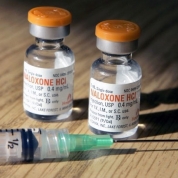Naloxone

Pharmacology
Naloxone has an extremely high affinity for μ-opioid receptors in the central nervous system. Naloxone is a μ-opioid receptor competitive antagonist, and its rapid blockade of those receptors often produces rapid onset of withdrawal symptoms. Naloxone also has an antagonist action, though with a lower affinity, at k and δ-opioid receptors.
There have been community Naloxone distribution via peer group networks in the UK for some years. There are currently plans to introduce a more family/relative friendly buccal spray, as some families and carers have reported time consuming difficulties in locating and using Narcan –filled syringes.
Naloxone is used as a secondary chemical in the drug Suboxone. Suboxone and Subutex are NICE licenced treatments for opioid dependence in the UK. Suboxone contains four parts buprenorphine and one part naloxone, while Subutex contains only buprenorphine. Naloxone was added to Suboxone in an effort to dissuade patients from crushing and snorting or injecting the tablets (sub-linguals).
Like Naltrexone, Naloxone has been shown to block the action of pain-lowering endorphins/dynorphins which the body produces naturally. The reason for this is that these endorphins operate on the same opioid receptors that naloxone blocks, hence the low mood and irritability that often affects people on Nalorex tablets.
